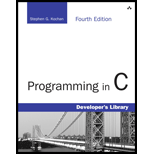
Write a function called s to extract a portion of a character string. The function should be called as follows:
s
where S is the character string from which you are extracting the substring, S is an index number into S indicating the first character of the S, c is the number of characters to be extracted from the S string, and r is an array of characters that is to contain the extracted substring.
For example, the call
s
extracts the substring̎ (three characters starting with character number 4) from the string̎ and places the result in r.
Be certain the function inserts a null character at the end of the substring in the result array. Also, have the function check that the requested number of characters does, in fact, exist m the string. If this is not the case, have the function end the substring when it reaches the end of the source string. So, for example, a call such as
s
should just place the string “words” inside the result array, even though 20 characters were requested by the call.
Want to see the full answer?
Check out a sample textbook solution
Chapter 9 Solutions
Programming in C
Additional Engineering Textbook Solutions
Starting Out With Visual Basic (8th Edition)
Concepts Of Programming Languages
Starting Out with Python (4th Edition)
SURVEY OF OPERATING SYSTEMS
Computer Science: An Overview (13th Edition) (What's New in Computer Science)
Java How to Program, Early Objects (11th Edition) (Deitel: How to Program)
 C++ Programming: From Problem Analysis to Program...Computer ScienceISBN:9781337102087Author:D. S. MalikPublisher:Cengage Learning
C++ Programming: From Problem Analysis to Program...Computer ScienceISBN:9781337102087Author:D. S. MalikPublisher:Cengage Learning C++ for Engineers and ScientistsComputer ScienceISBN:9781133187844Author:Bronson, Gary J.Publisher:Course Technology Ptr
C++ for Engineers and ScientistsComputer ScienceISBN:9781133187844Author:Bronson, Gary J.Publisher:Course Technology Ptr Systems ArchitectureComputer ScienceISBN:9781305080195Author:Stephen D. BurdPublisher:Cengage Learning
Systems ArchitectureComputer ScienceISBN:9781305080195Author:Stephen D. BurdPublisher:Cengage Learning New Perspectives on HTML5, CSS3, and JavaScriptComputer ScienceISBN:9781305503922Author:Patrick M. CareyPublisher:Cengage Learning
New Perspectives on HTML5, CSS3, and JavaScriptComputer ScienceISBN:9781305503922Author:Patrick M. CareyPublisher:Cengage Learning EBK JAVA PROGRAMMINGComputer ScienceISBN:9781337671385Author:FARRELLPublisher:CENGAGE LEARNING - CONSIGNMENTProgramming Logic & Design ComprehensiveComputer ScienceISBN:9781337669405Author:FARRELLPublisher:Cengage
EBK JAVA PROGRAMMINGComputer ScienceISBN:9781337671385Author:FARRELLPublisher:CENGAGE LEARNING - CONSIGNMENTProgramming Logic & Design ComprehensiveComputer ScienceISBN:9781337669405Author:FARRELLPublisher:Cengage





